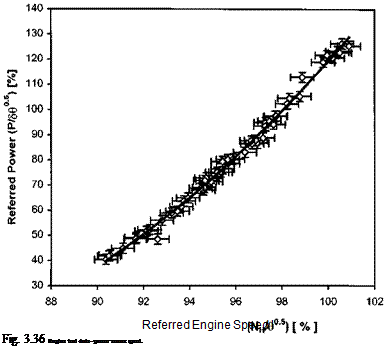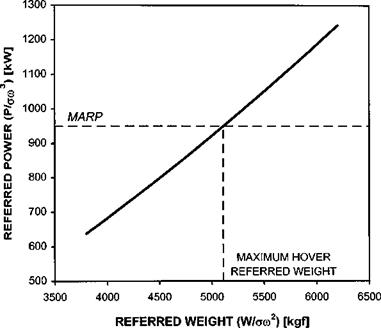DETERMINATION OF PERFORMANCE LIMITED PARAMETERS
Quite often one of the objectives of a flight test programme is to determine the parameter that will limit the performance under the atmospheric conditions likely to be experienced in the role. Under certain atmospheric conditions, usually hot and high, the engines, rather than the transmission will limit the performance. It is therefore necessary to determine the precise limiting factor for the conditions specified. The method is relatively simple but requires access to engine performance data such as that shown in Figs 3.36 and 3.37. The analysis proceeds by obtaining the actual limiting values from the aircraft documentation; these values will be called QLIMIT, rLIMIT and NLJM1T. Using the pressure altitude and air temperature specified the transmission limited referred power (TLRP) = QLIMIT m/8^9 is calculated. The engine temperature limited referred power (ETLRP) is obtained using Fig. 3.21 and the
 |
|
|
Referred Engine Temperature (Te/0) [ °С ]
|
Fig. 3.38 Limiting performance – level flight speed. |
|
Fig. 3.39 Limiting performance – hover mass. |

appropriate value of TLIMIT/0. Likewise the engine speed limited referred power (ESLRP) is found using Fig. 3.22 and the appropriate value of NLIMIT^0. If either ETLRP or ESLRP is less than TLRP then the performance will be engine-limited under the conditions specified.
It is now possible to determine the maximum performance available by choosing the lowest limited referred power, now called LRPMIN, and for a given rotor speed calculating the maximum available referred power (MARP) from:
This value can then be used to determine a variety of performance limited parameters, such as: the maximum level flight speed, VH, (see Fig. 3.38), maximum hover mass (Fig. 3.39) or maximum vertical rate of climb at a given hover mass (Fig. 3.40).
Chapter 4














